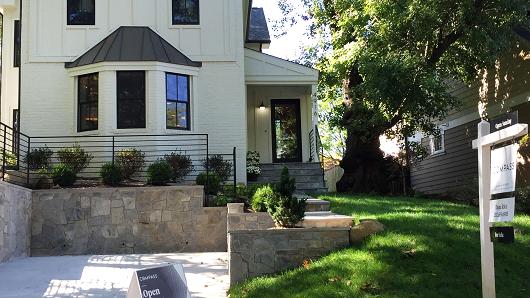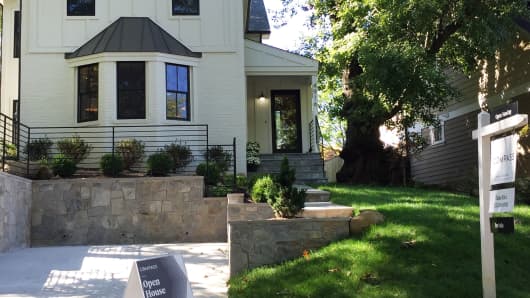Last June, Dana Rice, a real estate agent and house flipper, was deep in the throes of a massive remodeling project.
She had bought a 1938 home in an upscale neighborhood of Bethesda, Maryland, for $600,000 and intended to flip it for a hefty profit. Four months and $400,000 in construction costs later, Rice put the home on the market last weekend for $1,469,000. A million dollars of her money is at stake.
“Getting into the project is a risk because of the amount of money that you’re putting in, but overall at the end of the day, the ratio is the same,” Rice said as she put out candles and fliers for the first open house.
Rice added significant square footage, along with high-end finishes throughout. The so-called industrial cottage-style home is now 2,650 square feet with five bedrooms and three bathrooms. There is a small back patio, but the yard was sacrificed to make the home larger.
Rice says it is the opposite of the McMansion trend — not a tiny home for sure, but a ‘not-so-big’ home with top-of-the-line appliances, lighting, flooring, fixtures and systems.
“There is always a market for high-end because you’re differentiating your product from, let’s say, the masses,” said Rice. “In this particular area, for this particular house, I’m very confident because I feel as though the product we delivered — we really sweated the details on it, and I’m already getting great response from people who are looking at fixtures, textures colors, and it’s not what they see in the general renovation flip.”
Not only is house flipping on the rise in today’s increasingly competitive market, but average gross profits are now the highest since 2000, or since ATTOM Data Solutions, a real estate sales and analytics firm, began tracking flips.
House flippers in the second quarter of this year saw an average gross profit of $62,000, up from $57,900 in the second quarter of 2015. That gross profit represented an average 48.8 percent return on the original purchase price, up from a 47.5 percent a year ago.
“Home flipping is becoming more accessible for smaller operators thanks to an increasingly competitive lending environment with more loan options for real estate investors, who are also benefiting from the historically low mortgage interest rates,” said Daren Blomquist, senior vice president at ATTOM Data Solutions. “That favorable lending environment for flippers has helped to fuel the recent flipping frenzy we’ve seen over the past five quarters.”
A total of 51,434 sales of single family homes and condos were completed flips in the second quarter, up 14 percent from the previous quarter and up 3 percent from a year ago to the highest level in six years. [ATTOM defines a flip as a property sold in an arms-length sale for the second time within a 12-month period based on publicly recorded sales deed data.]
“It’s so fast and it’s so hot, you really have to be careful about who’s doing the work, because you’re going to pay that premium just to get that flip, but you need to look behind the curtain to see how they did it,” Rice cautioned.
Close to 40,000 investors, both individuals and institutions, completed at least one home flip in the second quarter of this year, the highest number in nine years. Home flipping peaked about 10 years ago, during the height of the housing boom, when mortgages were easier to pick up than a quart of milk. That is not the case today.
“While an increasing number of flippers are financing their purchases, more than two-thirds are still using cash to purchase compared to about one-third using cash to purchase back in 2006,” said Blomquist.
With so many new flippers in the market, the concern is in the craft. Rice actually spent more than a year remodeling her house, her fourth flip. That is longer than usual, but at her price, the house had to match the high-end market.
“The market is pretty strong for fixtures, finishes — everybody watches the TV shows. They have an expectation, and we want to meet it,” said Rice.
There were also a few bumps along the way.
“In the TV shows, it’s always this big dramatic thing, and then they go to commercial. That actually happens,” Rice said in an interview last June. “It’s either new plumbing from the main line, we had to tear off an entire section of a house and rebuild it that wasn’t in the budget, but in the end, you know that you make contingency plans to make sure that you can accommodate whatever you see when you start working.”
And so on a windy October Sunday, Rice opened the home to the public for the first time. With few listings in the neighborhood, the open house was well-attended.
Doug and Marisa Chartier and their two young daughters were the first to arrive. They live in Virginia but are looking for something different. The fact that the house was totally gutted as a flip made it that much more attractive to them.
“Ultimately some of the construction back in the day seems to be more solid and sturdy, so if there is a decent foundation and the inside finishings are good, …” began Doug.
“… I think for us, having had somebody else do all the work is great. There are a lot of houses around here that are old and ready to turn over and need an update,” Marisa added.
While the turnout Sunday was good, there were no immediate offers. Rice, who admits to selling homes recently in the area in just a few days, said she is not worried:
“Location and quality will always win the day. And location — did I say that already?”
source”gsmarena”





